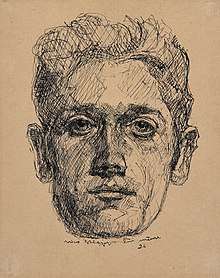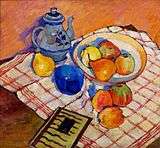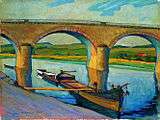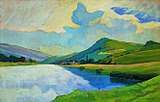Nico Klopp
Nico Klopp (1894–1930) was a Luxembourg painter remembered above all for his post-impressionist paintings of scenes on the River Moselle where he lived.[1]

Early life
Born on 18 September 1894 at Bech-Kleinmacher on the Moselle in south-eastern Luxembourg, Klopp attended the Arts and Crafts School in Luxembourg before studying art in Cologne (1916-1918) and Weimar (1919-1920).[2]
Career
In the mid-1920s, he was among those who reacted not just against the trends of the 19th century but also against the impressionists, inspired by artists such as Vincent van Gogh and Paul Cézanne. Together with Joseph Kutter and a group of other Luxembourg artists, he therefore broke away from the Cercle artistique de Luxembourg and became a co-founder of the Salon de la Sécession in 1927, inspired by secessionist developments in Munich, Vienna and Berlin.[3]
Klopp lived in Remich where he painted many pictures of the bridge over the Moselle. Both his landscapes and his still lifes are distinctive in their bright colouring and their solid strokes which clearly bring out the main subjects.[3] He exhibited his works at many salons and exhibitions in Luxembourg, Trier, Nancy, Bruges, and Echternach. He died in Luxembourg City on 29 December 1930 when he was only 36.[2]
Gallery
 Nico Klopp: Still Life with Fruit (1930)
Nico Klopp: Still Life with Fruit (1930) Nico Klopp: The Bridge at Remich (1925)
Nico Klopp: The Bridge at Remich (1925) Nico Klopp: Stretch of the Moselle at Greiveldange with Stadtbredimus (1930)
Nico Klopp: Stretch of the Moselle at Greiveldange with Stadtbredimus (1930) Nico Klopp: The Moselle near Schengen (1924)
Nico Klopp: The Moselle near Schengen (1924)
Bibliography
- "Nico Klopp (1894–1930)", Musée d'Histoire et d'Art, Editions Gérard Klopp, Luxembourg, 216 pp. ISBN 2-906535-85-0.
| Wikimedia Commons has media related to Nico Klopp. |
References
- "Klopp, Nico", Luxemburger Lexikon, Editions Guy Binsfeld, Luxembourg, 2006. (in German)
- Garry Little, "Luxembourg Stamps: 1994". Retrieved 21 January 2011.
- "Nico Klopp (1894-1930)" Archived 2011-07-18 at the Wayback Machine, Musée National d'Histoire et d'Art. (in French) Retrieved 21 January 2011.